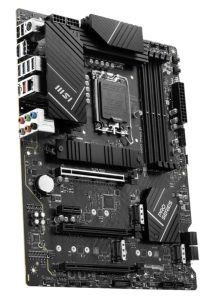Motherboards, the starting point for any PC build, do not consume a lot of power by themselves. Power use starts at around 20 Watts and tops out around 80 Watts, but many factors will influence these number.
Power Usage in PCs: An Overview
Power usage signifies the total energy consumed by the system to perform its designated tasks. Each part from the motherboard, CPU, GPU, to memory, storage devices, and peripherals, all contribute to the overall power consumption. High-end gaming PCs with powerful CPUs and GPUs use much more power than basic office computers or laptops.
Compared to any gaming GPU, the motherboard uses far less power. The motherboard is however responsible for supplying power to all other parts and some of it is lost along the way due to inefficiencies.
 Key Factors Impacting Motherboard Power Consumption
Key Factors Impacting Motherboard Power Consumption
Motherboard power consumption is influenced by several factors, including:
Component Compatibility: The power usage can surge if the motherboard and other system components like the CPU and RAM are not optimally matched or incompatible.
Component Efficiency: Energy-efficient devices consume less power while delivering equivalent performance, reducing the overall system power consumption.
Motherboard Features: The number of USB ports, SATA ports, and PCIe slots, among other features and functionalities, directly impact the motherboard’s power consumption.
System Load: The power consumption varies based on the system load. Lower power usage is observed during idle or low-intensity tasks than during heavy-duty tasks like gaming or rendering.
Estimating Motherboard Power Consumption
Estimating the exact power consumption of a motherboard can be tricky due to the lack of specific wattage figures from manufacturers. However, an estimate can be made by adding the power usage of the CPU, GPU, memory, storage devices, and peripherals, and then accounting for an additional 40-60 watts for the motherboard.
Typical Power Consumption Across Various Computers
The power consumption of motherboards can vary depending on the type and purpose of the computer system:
- Basic Office PC: A typical office PC’s motherboard power consumption ranges from 25 to 60 watts.
- Mid-Range Desktop PC: For a mid-range desktop system, the motherboard power consumption can be around 40 to 60 watts.
- High-End Gaming PCs and workstations: Gaming PCs with robust CPUs, gaming GPUs, and numerous peripherals can have a motherboard power consumption in the 60 to 80 watts or more range.
Measuring Motherboard Power Consumption: The Techniques

There are several methods to measure motherboard power consumption accurately:
- Kill-A-Watt Meter: A device that measures power consumption by connecting the entire computer system to it.
- Software Tools: Tools like HWMonitor or Open Hardware Monitor provide real-time monitoring of power consumption.
- PSU Monitoring: Some high-end PSUs offer monitoring capabilities that provide detailed information on power consumption. One example is EVGA’s SuperNova.
The Role of the Power Supply Unit (PSU)
Selecting the correct PSU is crucial for optimal performance and longevity of system components. An inadequate PSU can lead to system instability, crashes, and even damage to components. The PSU’s wattage should cover the total power consumption of the system, including the motherboard and all other components. PSUs with an 80 PLUS certification, guaranteeing a minimum efficiency of 80%, are recommended.
Tips to Minimize Motherboard Power Consumption
There are several ways to reduce motherboard power consumption:
- Enable power-saving features.
- Upgrade to energy-efficient components.
- Optimize system load.
- Use an energy-efficient PSU.
Wrapping Up
Understanding motherboard power consumption is important for managing your computer’s power efficiency and ensuring optimal system performance. By selecting the appropriate PSU, upgrading to energy-efficient components, and implementing power-saving strategies, you can ensure a more energy-efficient PC experience.
Frequently Asked Questions
Do motherboards have a maximum wattage? Yes, motherboards have a maximum power limit or wattage, which varies depending on the model.
How many watts does RAM use? The power consumption of RAM varies depending on its type and speed. On average, DDR4 RAM uses around 1.2-1.4 watts per module.
How many watts does my CPU use? The power consumption of the CPU can be checked on the manufacturer’s website or by using software like CPU-Z.
Is 1000 watts a lot for a PC? For a typical home or office PC, 1000 watts is excessive. However, for high-performance gaming or workstation PCs, 1000 watts might be necessary.
How many watts is a PC power supply? The wattage of a PC power supply can vary depending on the specific model and components. Standard wattage ranges include 300W, 500W, 750W, and 1000W.
 Key Factors Impacting Motherboard Power Consumption
Key Factors Impacting Motherboard Power Consumption